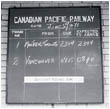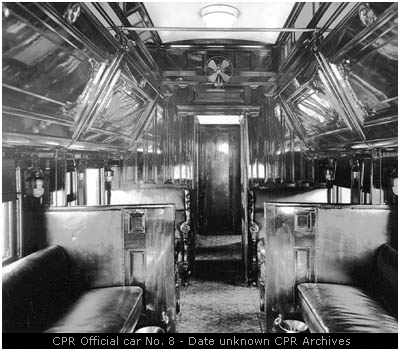|
 CPR's Piedmont station located in the Laurentian Mountains of
Quebec.
CPR's Piedmont station located in the Laurentian Mountains of
Quebec.
 Enclosed and heated octagonal water tank at MacGregor,
Manitoba.
Enclosed and heated octagonal water tank at MacGregor,
Manitoba.
 Safety first sign on the Brandon roundhouse.
Safety first sign on the Brandon roundhouse.
 Freight office at North Battleford,
Saskatchewan.
Freight office at North Battleford,
Saskatchewan.
 Train arrival board on a prairie station.
Train arrival board on a prairie station.
 CPR baggage cart.
CPR baggage cart.
 Caboose 436484 at Edmonton. Note the conductor's mark, a
tea pot mounted on a pole above the cupola.
Caboose 436484 at Edmonton. Note the conductor's mark, a
tea pot mounted on a pole above the cupola.
 The fans used to exhaust fumes from the Connaught
tunnel at the west portal.
The fans used to exhaust fumes from the Connaught
tunnel at the west portal.
 Moose Jaw ice house. Ice was used in reefers and passenger
cars for cooling.
Moose Jaw ice house. Ice was used in reefers and passenger
cars for cooling.
 Close-up of loading chute on the Moose Jaw ice
house.
Close-up of loading chute on the Moose Jaw ice
house.
 Scale house at Brandon, Manitoba.
Scale house at Brandon, Manitoba.
 Interlocking semaphore at CP-CN diamond near
Vegraville, Alberta.
Interlocking semaphore at CP-CN diamond near
Vegraville, Alberta.
|
|
Colonial
Red
Why is this article titled "Colonial Red"
when everything is black and white? Ah, now, therein lies the story.

Most Foamers (Railfans) have heard the story how Canadian Pacific Railway's steel
passenger equipment came to be painted the colour it was. Originally CPR passenger
cars were constructed of Mahogany wood which has a reddish colour. The wood was
covered by several coats of varnish to protect it. (This produced another name for
passenger cars, "Varnish", which came to mean sparkling first class
passenger rolling stock.)
When steel passenger cars were introduced the paint applied appears to be an attempt
to match this Mahogany colour. This may or may not be true, who knows? Early paint
pigments were produced from iron oxide which has a brownish-red or rust
colour to it. This paint was inexpensive to manufacture and found widespread use on
barns, buildings, and box cars around the turn of the century.
Now let's talk about colour itself, a very subjective topic. Colour is how the eye
interprets light reflected from a surface. The material reflecting the light
determines the colour. The amount and angle of the light reflected can also change
the colour. The time of day can change colour, likewise, atmospheric conditions change
colours we see. This also doesn't take into account fading of a painted surface.
Your computer's monitor can be used to show the effect of brightness. Too bright and
the colours are washed out, faded. Too dark and you can't see the details plainly.
Test this for yourself.
Is it any wonder Foamers use multiple names for the colour of CPR's equipment? Tuscan,
maroon, boxcar red, CPR red, and just plain red. But I'm talking about Colonial Red here. I'll
define Colonial Red for you this way, so there won't be any argument. Look at the
tender of CPR Hudson 2816, the Empress. The tender is basically black except for the
sides. There is a "Deluxe Gold" (yellow) trim around a Colonial Red panel
on each side with the words Canadian Pacific, also lettered in Deluxe Gold, in the
center.
Now you know what colour I'm talking about here, but where did this name Colonial
Red come from? Most CPR employees seem to call this colour Maroon, let me tell you
why I call it Colonial Red. It's not just because it sounds classy, and that it has a
historical flavour to it, but that certainly helps.
Many years ago while attempting to match this colour for a structure painting project
I visited the CPR Bridge and Buildings Department at Kemptville, Nova Scotia. My hope
was to obtain some actual "CPR paint". They didn't have any, but told me
it was mixed by a local hardware company, to their specifications. Now you Foamers who
know the history of CPR and the Dominion Atlantic will know this Maritime railway has
been around for quite some time. What you may not know, is, Maritimer's are very aware
of their history and how things came to be the way they are today. When it came to
their railway buildings these CPR Kemptville employees were quite sure of their paint
too. They called it Colonial Red.
You won't find much Colonial Red today. 2816's running boards, it's tender, the Royal
Canadian Pacific excursion equipment, the Historical Display cars, Track Evaluation
Car 63, and the odd business car. Colonial Red buildings are also disappearing fast.
There are a few stations remaining still painted in Colonial Red but they exist now
as museums. Some have undergone repainting over the years and the current colours
don't reflect the original colours.
 This brings us full circle to the above mentioned
title. This article is a photo essay on structures, signs, and equipment photographed
during CPR's Colonial Red era, or what was left of it at that time. All the attached
black and white photos were taken over thirty years ago during 1970, or 1971, in
various parts of Canada when it was still relatively easy to locate Colonial Red
structures. This brings us full circle to the above mentioned
title. This article is a photo essay on structures, signs, and equipment photographed
during CPR's Colonial Red era, or what was left of it at that time. All the attached
black and white photos were taken over thirty years ago during 1970, or 1971, in
various parts of Canada when it was still relatively easy to locate Colonial Red
structures.
 Most photos were taken with an old Eastman Kodak
Company bellows camera labeled with a patent date of 1910. It was manufactured in
Rochester, New York, date unknown. This camera uses a film size called VP116 (No
longer available.) producing postcard sized negatives. The camera speed is adjustable
from 1/25 to 1/100 of a second. The aperture is adjustable from 4 to 128, and that's
probably not in F stops! A viewfinder attached to the front face of the bellows above
the lens makes closeup shots impossible due to being offset from the lens. The fixed
lens produces a soft image unlike today's 35mm cameras with their precise optics. The
prints from this camera were scanned with a Hewlett Packard flat-bed
scanner at 1,200 dots per inch. Most photos were taken with an old Eastman Kodak
Company bellows camera labeled with a patent date of 1910. It was manufactured in
Rochester, New York, date unknown. This camera uses a film size called VP116 (No
longer available.) producing postcard sized negatives. The camera speed is adjustable
from 1/25 to 1/100 of a second. The aperture is adjustable from 4 to 128, and that's
probably not in F stops! A viewfinder attached to the front face of the bellows above
the lens makes closeup shots impossible due to being offset from the lens. The fixed
lens produces a soft image unlike today's 35mm cameras with their precise optics. The
prints from this camera were scanned with a Hewlett Packard flat-bed
scanner at 1,200 dots per inch.
I hope you enjoy this short walk through Canadian Pacific's Colonial Red period of
their history. It may bring back memories for some of you.
Bibliography
History of the Canadian Pacific Railway
W. Kaye Lamb - 1977
MacMillan Publishing Co.
The Last Spike
Pierre Burton - 1971
McClelland and Stewart Ltd.
Canadian Pacific A Brief History
J. Lorne McDougall - 1968
McGill University Press
The CPR West
Hugh A. Dempsey - 1984
Douglas & McIntyre Ltd.
Associated Links
Canadian Pacific Railway
Royal Canadian Pacific
CPR SIG
CPR Locomotive Roster
Mile 77
Brian Switzer's Photographs
Old Time Trains
©
2005 William C. Slim
http://www.okthepk.ca
|
|
|